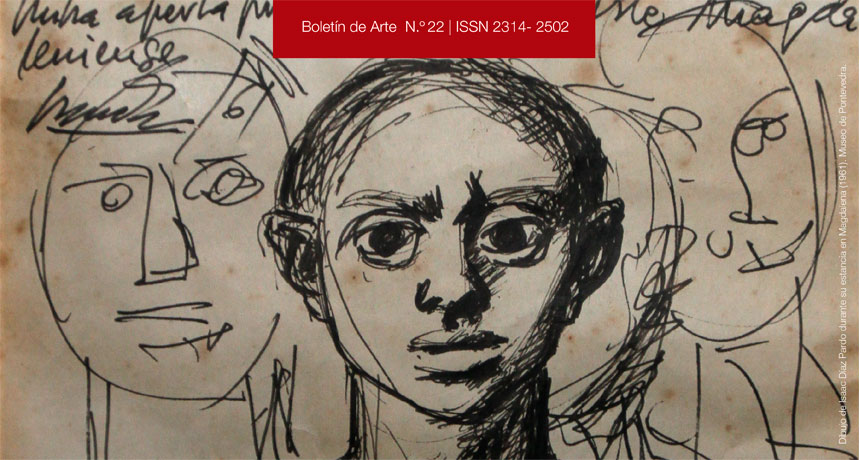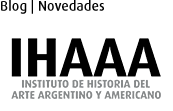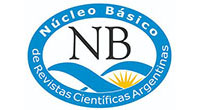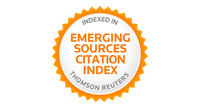Diaspora and Acculturation in Manuel Ángeles Ortiz
A Modern View of Patagonia (1941-1943)
DOI:
https://doi.org/10.24215/23142502e036Keywords:
Manuel Ángeles Ortiz, exile, Argentina, litography, sculptureAbstract
This article focuses on the production of Manuel Ángeles Ortiz in Patagonia, between 1941 and 1943, during his exile in Argentina. Within it, we will refer to the lithographs he made for his portfolio A campo abierto (1941) and for the book Patagonie (1942) by the Frenchman Roger Caillois, investigating the repercussion achieved with them. We will analyze his sculptural Construcciones, which he exhibited during 1943 at the Galería Müller in Buenos Aires, the same year in which he held a retrospective exhibition of drawings at the Galería Luisa Fanning. Both exhibitions were accompanied by reviews and notes published in the magazine Correo Literario, founded in November of that year by the Galicians Luis Seoane, Lorenzo Varela and Arturo Cuadrado.Downloads
References
Bachmann, H. N. (1946). Solitarios del arte. Ciudad Autónoma de Buenos Aires, Argentina: Poseidón.
Berry, A. M. (febrero de 1942). Manuel Ángeles Ortiz: estampas litográficas (Buenos Aires, 1941). Sur, (89), 72-73.
Bonet, J. M. (1996). Manuel Ángeles Ortiz, en pos de su verdad. En L. Davidov y E. Carmona (Dir.), Manuel Ángeles Ortiz (pp. 81-89). Madrid, España: Museo Nacional Centro de Arte Reina Sofía.
Brughetti, R. (1.o de enero de 1944). Aspectos parciales de la joven pintura en 1943. Correo Literario, 1(4), 7.
Davidov, L. y Carmona, E. (Dir.). (1996). Manuel Ángeles Ortiz. Madrid, España: Museo Nacional Centro de Arte Reina Sofía.
De Iturbide, J. (enero de 1943). Roger Caillois. Patagonia. Saber Vivir, (30), 63
Farías, J. (1º de diciembre de 1943). Manuel Ángeles Ortiz. Correo Literario, 1(2), 5.
González Lanuza, E. (15 de febrero de 1944). Maderas y Piedras en los Poemas Plásticos de Manuel Ángeles Ortiz. Correo Literario, 2(7), 5.
Gutiérrez Viñuales, R. (2017). Manuel Ángeles Ortiz. Memoria de la Argentina. Granada, España: Diputación.
Gutiérrez Viñuales, R. y Seixas Seoane, M. A. (Coords.). (2007). Buenos Aires. Escenarios de Luis Seoane. La Coruña, España: Fundación Luis Seoane.
J. O. E. (José Otero Espasandín). (1943). A propósito de la última exposición de Ángeles Ortiz. De Mar a Mar, 2(6).
Kirstein, L. (1943). The Latin-American Collection of the Museum of Modern Art [La Colección Latinoamericana del Museum of Modern Art]. Nueva York, Estados Unidos: Museum of Modern Art.
Lyon Haight, A. (Ed.). (1946). Portrait of Latin America as seen by her print makers [Retrato de Latinoamérica hecho por sus artistas gráficos]. Nueva York, Estados Unidos: Hasting House Publishers.
Manuel Ángeles Ortiz, retrospectivo. (12 al 18 de noviembre de 1943). Revista El Cicerone Porteño, s. p.
Panea Bonafé, L. (2007). Países de Manuel Ángeles Ortiz. En Manuel Ángeles Ortiz. Países (pp. 5-27). Granada, España: Esparvel.
Payró, J. E. (mayo-junio de 1943). Crítica de arte. Construcciones de Manuel Ángeles Ortiz. Sur, (104), 109-110.
Rinaldini, J. (2 de agosto de 1943). Artes plásticas. Obras de Manuel Ángeles Ortiz. El Mundo, pp. 15-16.
Rojas Paz, P. (5 de agosto de 1943). Es un éxito artístico la exposición de Ángeles Ortiz. Crítica, pp. 10-11
Romero Brest, J. (octubre de 1943). El Arte de Manuel Ángeles Ortiz. Saber Vivir, 4(38), 52.
Schwarzstein, D. (2001). Entre Franco y Perón. Memoria e identidad del exilio republicano español en Argentina. Barcelona, España: Crítica.
Serrano Plaja, A. (1945). Manuel Ángeles Ortiz. Ciudad Autónoma de Buenos Aires, Argentina: Poseidón.
Downloads
Published
How to Cite
Issue
Section
License
According to these terms, the material can be copied and redistributed by any means or in any format as long as a) the author and original source of the publication are quoted (magazine and URL of the work), access to the license is provided and whether changes have been made is mentioned; and b) the material is not used for commercial purposes.
The cession of non-exclusive rights means that after the publication (post print) in Boletín de Arte the authors can publish their work in any language, means and format; in such cases it must be mentioned that the material was originally published in this magazine.
Such cession also means the authorization of the authors for the work to be collected by SEDICI, the institutional archive of the National University of La Plata, and to be spread in the databases that the editorial team considers appropriate to increase the visibility of the publication and its authors.
Moreover, the magazine encourages the authors to deposit their productions in other institutional and thematic archives under the principle that offering the society the scientific and academic production without any restrictions contributes to a greater exchange of the global knowledge.
































